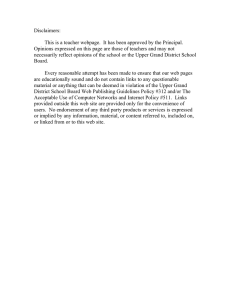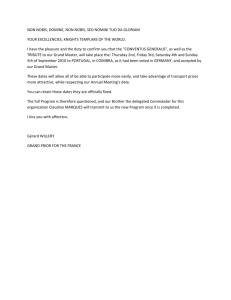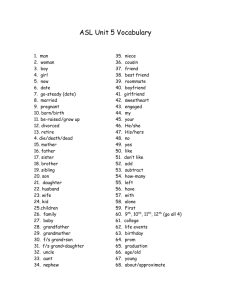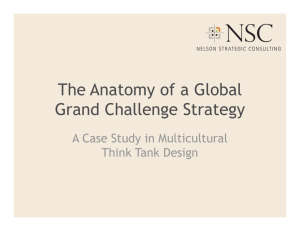COMPARATIVE GRAND STRATEGY AND MILITARY DOCTRINE-(Fall 2004) Lecture I----Part One--Course Overview
advertisement
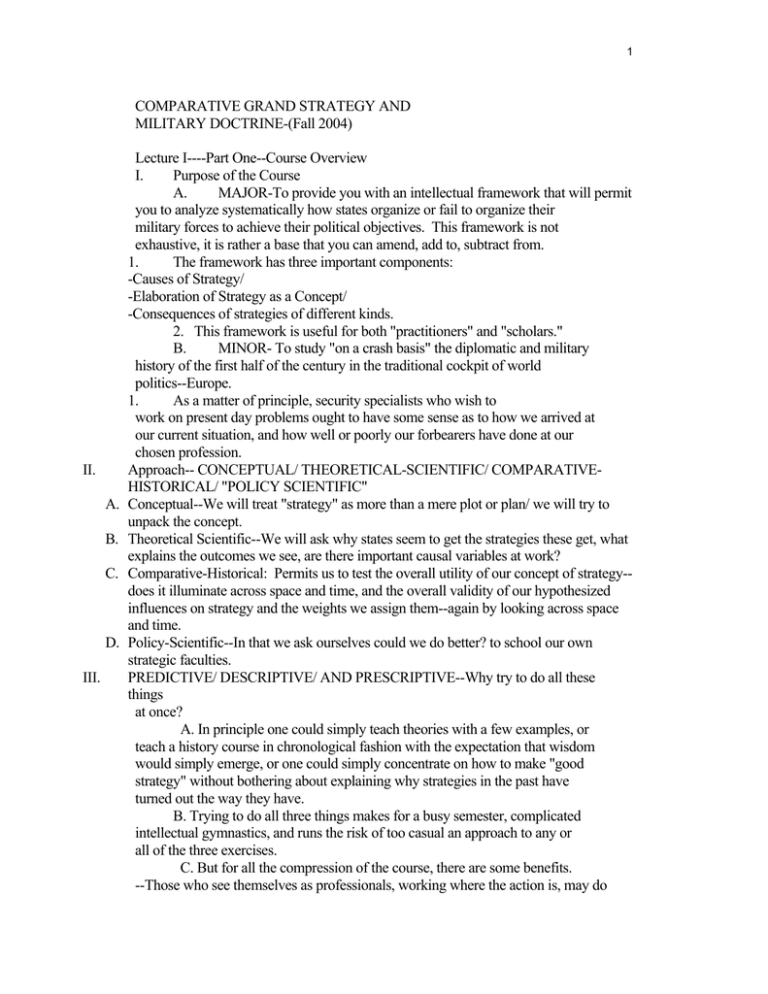
1 COMPARATIVE GRAND STRATEGY AND MILITARY DOCTRINE-(Fall 2004) II. A. B. C. D. III. Lecture I----Part One--Course Overview I. Purpose of the Course A. MAJOR-To provide you with an intellectual framework that will permit you to analyze systematically how states organize or fail to organize their military forces to achieve their political objectives. This framework is not exhaustive, it is rather a base that you can amend, add to, subtract from. 1. The framework has three important components: -Causes of Strategy/ -Elaboration of Strategy as a Concept/ -Consequences of strategies of different kinds. 2. This framework is useful for both "practitioners" and "scholars." B. MINOR- To study "on a crash basis" the diplomatic and military history of the first half of the century in the traditional cockpit of world politics--Europe. 1. As a matter of principle, security specialists who wish to work on present day problems ought to have some sense as to how we arrived at our current situation, and how well or poorly our forbearers have done at our chosen profession. Approach-- CONCEPTUAL/ THEORETICAL-SCIENTIFIC/ COMPARATIVEHISTORICAL/ "POLICY SCIENTIFIC" Conceptual--We will treat "strategy" as more than a mere plot or plan/ we will try to unpack the concept. Theoretical Scientific--We will ask why states seem to get the strategies these get, what explains the outcomes we see, are there important causal variables at work? Comparative-Historical: Permits us to test the overall utility of our concept of strategy-does it illuminate across space and time, and the overall validity of our hypothesized influences on strategy and the weights we assign them--again by looking across space and time. Policy-Scientific--In that we ask ourselves could we do better? to school our own strategic faculties. PREDICTIVE/ DESCRIPTIVE/ AND PRESCRIPTIVE--Why try to do all these things at once? A. In principle one could simply teach theories with a few examples, or teach a history course in chronological fashion with the expectation that wisdom would simply emerge, or one could simply concentrate on how to make "good strategy" without bothering about explaining why strategies in the past have turned out the way they have. B. Trying to do all three things makes for a busy semester, complicated intellectual gymnastics, and runs the risk of too casual an approach to any or all of the three exercises. C. But for all the compression of the course, there are some benefits. --Those who see themselves as professionals, working where the action is, may do 2 a better job if they have a sense of the underlying dynamics at work in the formulation of strategy. --Those who see themselves primarily as scholars can guard against excessive determinism by considering how they might have done better --The focused study of historical cases imposes discipline on theorists--the discipline of "testing", and provides vicarious experience for the prospective practitioner. [A little like Clausewitz view of the study of the study of military history] IV. FORMAT-Reading--Classroom-Writing A. This is a reading course. Lots of it. A good bit of it is not in the books. --Course will not work especially well for you if you do not read what has been assigned--includes auditors, especially true of discussion. B. Writing Assignments-Basis for your grade in the course --Two short essays, and a take-home final—Takehome, technically due the last official class day of the term; I have been known to grant blanket extensions. --The paper due dates are real. --Paper due dates coincide roughly with the reading. First paper should cover theoretical-conceptual material. Second paper should deal with the first world war. The final will cover everything ; I write the questions. --Papers will be based largely on assigned readings. You will determine your own topic. You may consult me, however, on topic and execution. I will not, however, read and critique drafts. Papers could take the form of a critique of several pieces, a synthetic effort, the application of concepts or theories to particular historical episodes presented in the course, a more daring application of same to a substantive area not developed in the course; or if you choose to read an entire book listed as supplementary reading, a review essay. The stress here is on essay writing, not story-telling. I want to see you really wrestle with the material. These instructions also apply to the final. See the syllabus for bit more elaboration. C. Class-Meeting-Format. Since you are mostly graduate students, I do not believe that I should simply confine our meetings to lectures. -But You are entitled to hear what I have to say about the literature and the issues raised each week. -Therefore, I will usually come in with some prepared material in the earlier part of the term and we’ll move to almost all discussion as the term progresses. Please come in with some prepared questions or comments just to keep things rolling along. D. Undergraduates:.[ See me after class.] 3 V. Organization (SEE SYLLABUS) Section 1, roughly the first three weeks of the course will -define the concept of grand strategy, and offer a set of questions and analytical categories that we shall use to evaluate the strategies selected for study. --Examine some of the critical influences that shape the grand strategies of nations-- including NATIONAL POWER/ GEOGRAPHICAL POSITION/ MILITARY TECHNOLOGY/ THE STRUCTURE AND NATURE OF MODERN MILITARY ORGANIZATIONS/ SOCIAL DEVELOPMENT, ESPECIALLY NATIONALISM. (EXPLANATION part of the exercise) --Examine the nature of the international political system to better understand some of the consequences of strategies of different types. (JUDGEMENT part of the exercise) --We’ll spend a week talking about historical case studies; and use my old book as our reference point. Section 2 of the course deals with the strategy of the great powers in the years leading up to World War I: France, Germany, Britain, Russia, the outbreak and conduct of the war. (also Austria-Hungary) --Expecially interested in the causes and consequences of the "Cult of the Offensive" Section 3 deals with the strategy of the three major powers in central Europe in the inter-war period--France, Britain, and Germany, (my book); the initial battles of the war. It also deals a bit with Soviet strategy in the l930's. --Especially interested in the "Cult of the Defensive" In both periods, we will endeavor to determine -what the grand strategy seems to have been; -what were the principal influences on the strategy; -what were the political and military consequences; including success or not. -We will always have three broad tasks in mind CHARACTERIZATION, JUDGEMENT and EXPLANATION. --CAVEAT--Very little diplomatic and military history is rigorously organized around the concept of Grand Strategy. Indeed, there is not a lot of agreement on what a grand strategy actually is. So one cannot simply pick up a book or an essay that summarizes the grand strategy of most of the states that I have selected for study. --CONSOLATION PRIZE-- even if you determine in the end that the whole analytical framework of the course is a figment of my tortured imagination, it will have: --exposed you to some basic theories of why states do what they do in 4 international politics--especially balance of power theory and organization theory; --substantial diplomatic history --a great deal of military history, including the development of tactics and technology, as well as the conduct of key battles and campaigns. "Grand" or "Political-Military" Strategy Defined Lecture I- Part Two I. Caveats A. States do not always, or even frequently, state their grand strategies clearly, or write them down in one place. More often than not, they do not use the term. U.S. in recent years has used the terms “National Strategy” for Grand Strategy, and “National Military Strategy” for Military Doctrine. (Eisenhower's Massive Retaliation Strategy stated in NSC 162 is an example of one that was. Can be found in the Pentagon Papers.) B. Statesmen and soldiers do, however, --implicitly or explicitly-think, plot, and conspire in "strategic" fashion. II. What then do we mean by the term "Grand Strategy?" A. A core set of beliefs about national security found in the members of state's foreign policy and military elite. (Consensus would be too strong a word.) B. These beliefs can usually be characterized as a set of inter-connected political and military means and ends expected to produce "security." --(This term is not an objective one; a state's definition of security is not always one that an outside observer would agree with. 1. Highest-level political objectives are linked to middle-level political objectives, which are in turn linked to highest level military objectives, which are linked to lower order military objectives. Each link in the chain is both an end of the link below, and a means to the link above. This is merely an extension of Clausewitz's view of the military-political, meansends relationship. Duality of Means and Ends. --This image, which implies linearity, should not be taken too literally; it would be more exact to view Grand Strategy as a system of interlinked political and military means and ends. C. An IDEAL grand strategy would not only specify political and military means and ends, but explain why the proposed connections are expected to hold true? 1. For example a simple question during much of the 1990s would have been "Why is the commitment of roughly one-fifth of active US military resources to actual presence in Europe or its waters on a daily basis expected to produce "security" for the US?" Explanations of critical hypothesized linkages ought to be embedded somewhere in the strategy. D. This chain of political and military means and ends may thus, also be 5 viewed as a state's THEORY about how it can best "cause" security for itself. That theory is tested every day in the unregulated, competitive environment of international politics. III. What are the key questions that we shall wish to ask of each grand strategy that we examine? A. What is the grand strategy? As best we can, we shall draw a map of the core political-military means-ends chain. B. What are the key factors that seem to have influenced the grand strategy in question? 1. If we can systematize our understanding of these factors we will be better able to predict the strategies of other states, or at least explain them. C. What are the salient characteristics of the strategy. Those that seem to hold the greatest implications both for the security of the state itself, and the stability of the international political system. 1. At the political level, does the state aim to preserve or upset the status quo? To what extent? (Key ? because revisionist strategies seem to have important effects on the behavior of other states.) a. Those of us who subscribe to balance of power theory would argue that expansionists, or those who appear so, send to provoke coalitions against themselves unless they are very very clever.. --One fundamental question we shall ask this year is how was it that Wilhelmine Germany seemed to encircle itself, promoting a fairly cohesive opposing coalition, whereas Hitler managed to prevent such a coalition from forming until rather late in the game? 2. At the military level is the strategy OFFENSIVE, DEFENSIVE, OR DETERRENT --OFFENSIVE--DISARMING- BLITZKRIEG GERMAN AND ISRAELI STYLE --DEFENSIVE-DENIAL- US IN LATE 19TH AND EARLY 20TH CENTURY, WITH BRITISH, TWO OCEANS, and a FLEET; The BRITISH WITH THE CHANNEL AND THE FLEET; MAGINOT LINE --DETERRENT-PUNISHMENT- FINLAND, SWITZERLAND, YUGOSLAVIA, PRC, FRANCE AND BRITAIN WITH NUCLEAR WEAPONS --This is important because some have argued it affects the odds of arms races, probability of war, and perhaps even the intensity of war. Some would also say that it affects probability of success--since there are many strategists today, as has been true historically, who simply reject defense or punishment as appropriate ways to wage war, insist they are doomed to ultimate failure. --President Bush extols the virtues of the offensive in the War on Terror; says a purely defensive strategy won’t do the job. Even if you agree, is the mix right? 3. Is there a coherent relationship between the political and military 6 aspects of the strategy? POLITICAL-MILITARY INTEGRATION--Is this tight means-ends relationship for which Clausewitz argues present? a. Does the statesman have at hand the tools necessary to support his or her diplomatic activities. --A defensive military doctrine could not support revision of the status quo; no gunboat diplomacy without gunboats; you can't defend a global empire with meager resources; hard to practice coercive diplomacy with forces that have a go-no-go quality-such as mobilization army or the late 1950s US plans for general thermonuclear war. --Examples??— As the cold war ended, US military deployments took the form of wars of observation/peace keeping. Our forces were organized and their equipment was engineered for big wars. The inadvertent downing of an Iranian airliner revealed a problem. Bernard Trainor formerly of the NYT, formerly Deputy Chief of Staff of the USMC. NYT, "US as PeaceKeeper When Role Blurs" NYT, 8/6/88 p.3 --"The military has not yet found a formula, which insures its readiness to fight a war, while at the same time fielding forces that can walk the thin line between restrain and violence in politically complicated crises." --"...modern military equipment such as the Aegis system,...is also designed for battlefield situations that involve only friends and targets.." Swedish Submarine Incursions--On a smaller scale, the Swedish Navy began to design homing torpedos with pipsqueak warheads-designed to damage but not kill an enemy submarine--for peacetime defense against submarine intrusions by a great power whose submarines you'd rather warn than sink. --Between the Bush administration’s decision to add political re-engineering to the war on terror, and the European propensity to make peace and order on their periphery, especially throwing a wet blanket on civil wars a priority—we have seen a pretty significant growth in the West’s steady state requirement for ground force deployments. Yet, ground forces are probably the capability we shrunk the most after the Cold War. Steady state maybe a capacity to keep 300,000 persons in the field, with great strain. This permits you to have a ghost of a chance policing populations of roughly 30 million. Between Afghan, Iraq, and the Balkans we’re trying to do 60 million. And there is a move to add Sudan. We have to do less, get a lot better at doing it, or build more ground forces—which are both expensive and not too glamorous. b. Conversely has the statesman 7 asked "certain military moves and actions to produce effects that are foreign to their nature." "..orders that defeat the purpose they are meant to serve." Examples? --Bethman-Hollweg's submarine rules of engagement. --US constraints on bomb run profiles of aircraft hitting the Yalu bridges in late 1950 --Perhaps US Marines in Beirut? --US military in Najaf?? c. Does the strategy set priorities for both for ends and means. --The notion of priority is critical, because we live in a world of scarcity; (Why we have a science of economics) Bernard Brodie use to say that strategy wears a dollar sign; One could look at strategy as the production and distribution of scarce military means in terms of alternate political ends. --Big World --Many threats and many prizes imaginable. Which are most critical? --Many kinds of forces from which to choose. Air,sea,land, heavy light, which ones are most appropriate to the ends in view. --In World War II, over 40% of US GNP was mobilized for defense, but we still had to choose our battles; Europe, at least theoretically had first priority, the Pacific second, and Burma third. --Clausewitz makes much of concentration on the decisive point, which is a priority issue. 4. Innovation-- Do the political aspects of the strategy adapt to alterations in the political circumstances of the state? --Does the military strategy adapt to changes in the political strategy, military technology, or enemy military technique? (Example: some scholars argue that Sadat believed that Egypt and the whole Arab world had to give up the objective of destroying Israel, since it was probable that Israel owned nuclear weapons and could impose a prohibitive cost on the Arabs even if they did succeed against Israeli conventional forces.) (Example: in the 1930's , as we shall see, the German military adapted in superior fashion to the internal combustion engine and the radio --especially for the operations of tanks and fighter and tactical bombing aircraft. This put Germany in a position to win a series of major, swift, initial victories vs. France, Britain, and Russia. Germany's defensive potential was thus improved with territory and resources, substantially raising the dollar and human costs of ending her bid for hegemony. France and Britain responded less well to technological opportunities, and paid the price. 5. Finally, a "residual" category: Was the strategy successful? Why or 8 why not? --Did it keep the state secure? --Help it expand its power, if that was the objective --Were the costs affordable? --Some of the explanations for success or failure can be found in answers to the preceding questions? But there may be additional reasons for success or failure not covered by the questions I have outlined. If we discover any we shall surely wish to remember them.
